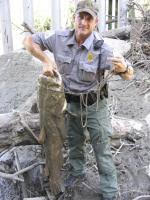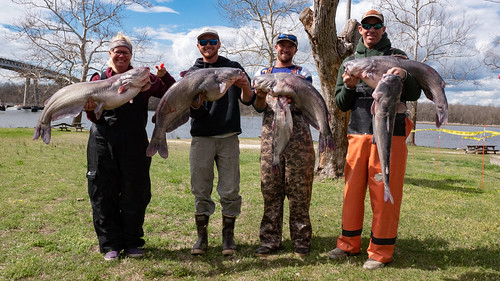Missouri: Department of Conservation Says Noodling Can Hurt Catfish Populations

Conservation Agent Eric Abbott nabbed four men handfishing and possessing this fish in the Tarkio River in Atchison County in August 2012. Abbott released the large flathead, topping 40 pounds, back into the river.
MDC Staff
Q: What is noodling?
A: Noodling is a common term for hand-fishing.
This is the method of reaching underwater into natural cavities formed in riverbanks or by tree roots, logs, or rocks and capturing a catfish by hand. When the catfish bites onto the hand, the noodler pulls the fish off the nest and out of the water. This method is primarily used to catch flathead catfish and blue catfish in Missouri when these fish are spawning or nesting in small rivers or streams.
Q: How popular is noodling or hand-fishing?
A: The common estimate is about 2,000 people in Missouri hand-fish. That number could top almost 13,000 if the practice was legalized.
A Missouri Department of Conservation survey of Missouri anglers shows that about 4.6 percent of those surveyed would be “very likely” to participate in hand-fishing if it was legalized. Based on fishing permit sales, that number could amount to almost 13,000 noodlers statewide.
Q: If other states allow hand-fishing, why does the Conservation Commission of Missouri oppose it?
A: In Missouri, flathead and blue catfish are valued as a top game fish and are therefore regulated under the state’s Wildlife Code.
According to survey information from the US Fish and Wildlife Service, catfishing ranks second in Missouri in both number of anglers and days spent fishing. It contributes almost $157 million annually to the Missouri economy. While some other states allow hand-fishing for catfish, most classify one or more catfish species as non-game fish.
Q: How would legalizing hand-fishing hurt our catfish numbers?
A: Research shows that legalizing hand-fishing could severely deplete local catfish populations and put the abundance of a top Missouri game fish at risk.
Catfish are very vulnerable during the nesting season (June and July) because they lay their eggs in natural cavities and then do not leave the nest. If they’re taken away, their eggs quickly die. Catfish on the nest are not vulnerable to being caught by traditional sport-angling methods.
Our research shows that less than 25 percent of catfish migrate from large rivers to smaller tributaries. This degree of migration depends on seasonal water levels. Hand-fishers have easy access to these smaller wading streams and the nesting cover catfish use, making these catfish especially vulnerable. A survey of hand-fishers conducted by the University of Missouri–Columbia Department of Parks, Recreation and Tourism reported that 90 percent of hand-fishers prefer to fish in smaller rivers or streams, which are most vulnerable to overharvesting.
Catfish are long-lived (reaching ages of 25 years or more), are relatively slow growing, and can reach weights exceeding 75 pounds. They also lay many fewer eggs than other sport fish.
In north and west-central Missouri, in particular, streams have been greatly altered over the past 100 years, reducing catfish habitat. Hand-fishing would place more pressure on these local catfish populations, which already have high harvest rates from current fishing practices.
Surveys show that hand-fishing tends to be highly successful. Because of its high success rate and focus on removing larger, older, sexually mature fish from their nests, hand-fishing could jeopardize local populations of this popular game fish.
According to a survey of hand-fishers conducted by the University of Missouri–Columbia Department of Parks, Recreation and Tourism, hand-fishers report being successful at capturing a catfish 60 percent of the time. That is an extremely high success rate compared to other angling methods.
Hand-fishers reported their average catch weighed approximately 20 pounds, which they considered to be a minimum-size catch. They preferred to catch larger, trophy-size, 50-pound flathead catfish.
Q: Has the Department of Conservation ever considered legalizing hand-fishing?
A: In responding to ongoing requests by hand-fishers to have the activity legalized, the Department of Conservation offered an experimental hand-fishing season in 2005 and 2006.
The experimental season was part of a larger, comprehensive research study of flathead catfish and blue catfish in segments of eight rivers in Missouri. It included the potential impact of hand-fishing on catfish populations. Hand-fishing was allowed in parts of three rivers in Missouri. Hand-fishers were required to purchase a special hand-fishing permit and complete a report of their activity at the end of each experimental season.
Based on research findings that showed hand-fishing could have a significant negative impact on catfish numbers, the Conservation Commission voted to end the experimental hand-fishing season in April 2007. Project results since 2007 have not provided evidence to alter the decision made by the Commission.
Q: What do fishing organizations think about hand-fishing?
A: Other Missouri conservation and fishing organizations are also opposed to hand fishing.
The Conservation Federation of Missouri — the state’s largest citizen conservation group — strongly opposes hand-fishing, and so do the Federation’s many affiliated fishing groups.







